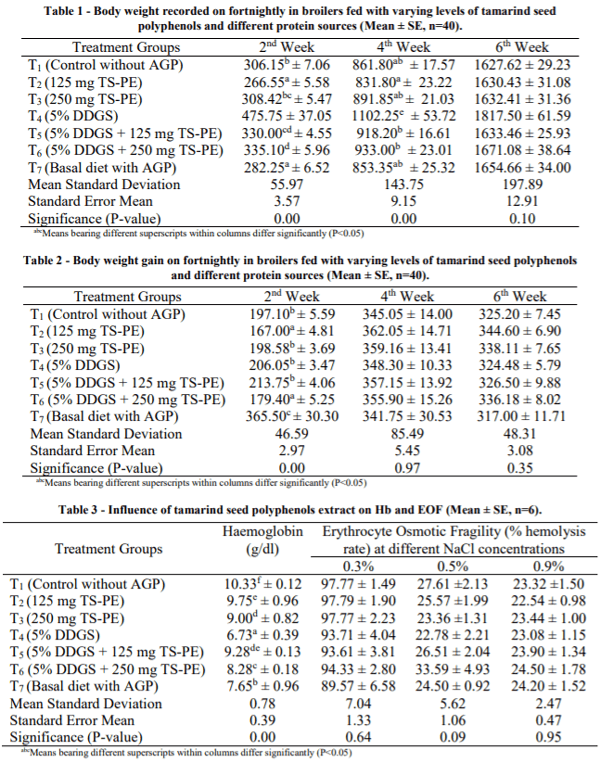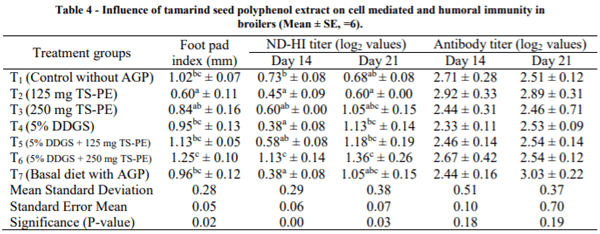Production, Haematological and Immunological Attributes of Broilers Fed Diets Supplemented with Tamarind Seed Based Polyphenols Extract
The present experiment was designed to investigate the effect of tamarind polyphenols under different dietary protein diets (soybean and DDGS) on production, physiological and immunological attributes in broilers. Day old chicks (n=280) were randomly distributed into 7 treatment groups with 5 replicates each containing 8 birds. All birds were provided with feed and water ad libitum and maintained in experimental pens during tropical conditions (temperature 34-41°C and 47% humidity). Polyphenols were fed at 125 and 250 ppm with and without distillers dried grains with solubles (DDGS) and antibiotic growth promoter (AGP). One way analysis of variance (ANOVA) was performed to assess the significant difference among treatment groups. Results indicated that experimental diets supplemented with polyphenols (T2, T3) alone significantly (P<0.01) reduced haemoglobin (Hb) levels compared with the control (T1), while polyphenols supplemented at 125 and 250 ppm in combination with DDGS significantly improved Hb levels compared with the control (T4). Administration of polyphenols at 125 and 250 ppm in corn-DDGS diets increased (P<0.05) the immune response i.e., foot pad index in response to phytohaemagglutunin (PHA-P), Newcastle vaccination (ND) titres as compared with diets supplemented with DDGS (T4- control). Production performance did not show a significant difference among treatment groups. In conclusion, polyphenols at 125 and 250 ppm in combination with 5% DDGS improved (P<0.05) broiler production especially immunity and erythrocyte membrane resistance under hot climatic conditions.


Aengwanich W, Suttajit M, Srikhun T & Boonsorn T (2009) International Journal of Poultry Science 8: 749-751.
Brenes A, Viveros A, Chamorro S & Arija I (2016) Animal Feed and Science Technology 211: 1- 17.
Cheng S & Lamont SJ (1988) Poultry Science 67: 989-995. Cromwell GL (2002) Animal Biotechnology 13: 7-27.
Cuevas A, Saavedra N, Luis A, Salazar LA & Abdalla SPD (2013) Nutrients 5: 2314-2332.
Dai J & Mumper R (2010) Molecules 15: 7313-7352.
Egert S & Rimbach G (2011) Advances in Nutrition 2: 8-14.
Gopi M, Dutta N, Pattanaik AK, Jadhav SE & Mohan J (2017) Proceedings of Australian Poultry Science Symposium 28: 252-255.
Mašek T, Starcevic K & Mikulec Z (2014) European Poultry Science 78: doi:10.1399/eps.2014.64.
McCullough ML, Peterson JJ, Patel R, Jacques PF, Shah R & Dwyer JT (2012) American Journal of Clinical Nutrition 95: 454-464.
Paszkiewicz M, Budzynska A, Rozalska B & Sadowska B (2012) Post?py Higienyi Medycyny Doswiadczalnej 66: 637-646.
Quideau S, Deffieux D, Douat-Casassus C & Pouységu L (2011) Angewandte Chemie International Edition 50: 586-621.
Razali N, Mat-Junit S, Abdul-Muthalib AF, Subramaniam S & Abdul-Aziz A (2012) Food Chemistry 131: 441-448.
Sahli H (1909) Lehrbuch d. klin In: Untersuchungen Methode, 5 th Edition, pp. 846.
Yadav AS, Kolluri G, Gopi M, Karthik K, Malik YPS & Dhama K (2016) Journal of Experimental Biology and Agricultural Sciences 4: 368-383.


United States






